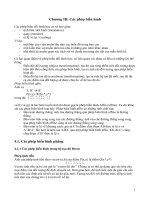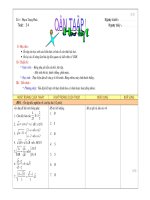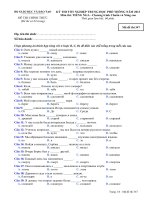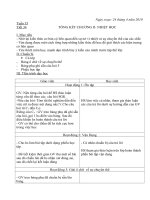Chuong 34
Bạn đang xem bản rút gọn của tài liệu. Xem và tải ngay bản đầy đủ của tài liệu tại đây (151.2 KB, 62 trang )
<span class='text_page_counter'>(1)</span><div class='page_container' data-page=1>
Chapter Thirty-Four
</div>
<span class='text_page_counter'>(2)</span><div class='page_container' data-page=2>
Information Technologies
<b>Computers, answering machines, </b>
<b>FAXes, pagers, cellular phones, …</b>
<b>Many provide strong </b>
<b>complementarities.</b>
<b>E.g. email is useful only if lots of </b>
<b>people use it -- a network externality.</b>
<b>And computers are more useful if </b>
</div>
<span class='text_page_counter'>(3)</span><div class='page_container' data-page=3>
Information Technologies
<b>But then switching technologies </b>
<b>becomes very costly -- lock-in.</b>
<b>E.g. Microsoft Windows.</b>
<b>How do markets operate when there </b>
</div>
<span class='text_page_counter'>(4)</span><div class='page_container' data-page=4>
Competition & Switching Costs
<b>Producer’s cost per month of </b>
<b>providing a network service is c per </b>
<b>customer.</b>
<b>Customer’s switching cost is s.</b>
<b>Producer offers a one month </b>
<b>discount, d.</b>
</div>
<span class='text_page_counter'>(5)</span><div class='page_container' data-page=5>
Competition & Switching Costs
<b>All producers set the same </b>
<b>nondiscounted price of p per month.</b>
<b>When is switching producers rational </b>
</div>
<span class='text_page_counter'>(6)</span><div class='page_container' data-page=6>
Competition & Switching Costs
<b>Cost of not switching is </b> <i><b>p</b></i> <i><b>p</b></i>
<i><b>r</b></i>
</div>
<span class='text_page_counter'>(7)</span><div class='page_container' data-page=7>
Competition & Switching Costs
<b>Cost of not switching is</b>
<b>Cost from switching is</b>
<i><b>p</b></i> <i><b>p</b></i>
<i><b>r</b></i>
<b>.</b>
<i><b>p d</b></i> <i><b>p</b></i>
<i><b>r</b></i> <i><b>s</b></i>
</div>
<span class='text_page_counter'>(8)</span><div class='page_container' data-page=8>
Competition & Switching Costs
<b>Cost of not switching is</b>
<b>Cost from switching is</b>
<b>Switch if </b>
<i><b>p</b></i> <i><b>p</b></i>
<i><b>r</b></i>
<b>.</b>
<i><b>p d</b></i> <i><b>p</b></i>
<i><b>r</b></i> <i><b>s</b></i> <i><b>p</b></i>
<i><b>p</b></i>
<i><b>r</b></i>
<b>.</b>
<i><b>p d</b></i> <i><b>p</b></i>
<i><b>r</b></i> <i><b>s</b></i>
</div>
<span class='text_page_counter'>(9)</span><div class='page_container' data-page=9>
Competition & Switching Costs
<b>Cost of not switching is</b>
<b>Cost from switching is</b>
<b>Switch if </b>
<b>I.e. if</b>
<i><b>p</b></i> <i><b>p</b></i>
<i><b>r</b></i>
<b>.</b>
<i><b>p d</b></i> <i><b>p</b></i>
<i><b>r</b></i> <i><b>s</b></i> <i><b>p</b></i>
<i><b>p</b></i>
<i><b>r</b></i>
<b>.</b>
<i><b>p d</b></i> <i><b>p</b></i>
<i><b>r</b></i> <i><b>s</b></i>
<b>.</b>
</div>
<span class='text_page_counter'>(10)</span><div class='page_container' data-page=10>
Competition & Switching Costs
<b>Switch if</b>
<b>I.e. if</b>
<b>Producer competition will ensure at a </b>
<b>market equilibrium that customers </b>
<b>are indifferent between switching or </b>
<b>not </b>
<i><b>p d</b></i> <i><b>p</b></i>
<i><b>r</b></i> <i><b>s</b></i> <i><b>p</b></i>
<i><b>p</b></i>
<i><b>r</b></i>
<b>.</b>
<i><b>d</b></i> <i><b>s</b></i><b>.</b>
</div>
<span class='text_page_counter'>(11)</span><div class='page_container' data-page=11>
Competition & Switching Costs
<b>At equilibrium, producer economic </b>
<b>profits are zero.</b>
<b>I.e. </b> <i><b>p d c</b></i> <i><b>p c</b></i>
<i><b>r</b></i>
</div>
<span class='text_page_counter'>(12)</span><div class='page_container' data-page=12>
Competition & Switching Costs
<b>At equilibrium, producer economic </b>
<b>profits are zero.</b>
<b>I.e. </b>
<b>Since , at equilibrium</b><i><b>d</b></i> <sub></sub><i><b>s</b></i>
<i><b>p d c</b></i> <i><b>p c</b></i>
<i><b>r</b></i>
<b>0.</b>
<i><b>p c</b></i> <i><b>p c</b></i>
<i><b>r</b></i> <i><b>s</b></i>
</div>
<span class='text_page_counter'>(13)</span><div class='page_container' data-page=13>
Competition & Switching Costs
<b>At equilibrium, producer economic </b>
<b>profits are zero.</b>
<b>I.e. </b>
<b>Since , at equilibrium</b>
<b>I.e. present-valued producer profit = </b>
<b>consumer switching cost.</b>
<i><b>d</b></i> <i><b>s</b></i>
<i><b>p d c</b></i> <i><b>p c</b></i>
<i><b>r</b></i>
<b>0.</b>
<i><b>p c</b></i> <i><b>p c</b></i>
<i><b>r</b></i> <i><b>s</b></i>
</div>
<span class='text_page_counter'>(14)</span><div class='page_container' data-page=14>
Competition & Network
Externalities
<b>Individuals 1,…,1000.</b>
<b>Each can buy one unit of a good </b>
<b>providing a network externality.</b>
<b>Person v values a unit of the good at </b>
</div>
<span class='text_page_counter'>(15)</span><div class='page_container' data-page=15>
Competition & Network
Externalities
<b>Individuals 1,…,1000.</b>
<b>Each can buy one unit of a good </b>
<b>providing a network externality.</b>
<b>Person v values a unit of the good at </b>
<b>nv, where n is the number of persons </b>
<b>who buy the good.</b>
<b>At a price p, what is the quantity </b>
</div>
<span class='text_page_counter'>(16)</span><div class='page_container' data-page=16>
Competition & Network
Externalities
<b>If v is the marginal buyer, valuing the </b>
<b>good at nv = p, then all buyers v’ > v </b>
<b>value the good more, and so buy it.</b>
<b>Quantity demanded is n = 1000 - v.</b>
</div>
<span class='text_page_counter'>(17)</span><div class='page_container' data-page=17>
Competition & Network
Externalities
<b>0</b> <b>1000</b>
<b>n</b>
<b>Willingness-to-pay</b>
<b> p = n(1000-n)</b>
</div>
<span class='text_page_counter'>(18)</span><div class='page_container' data-page=18>
Competition & Network
Externalities
<b>Suppose all suppliers have the same </b>
</div>
<span class='text_page_counter'>(19)</span><div class='page_container' data-page=19>
Competition & Network
Externalities
<b>0</b> <b>1000</b>
<b>n</b>
<b>Demand Curve</b>
<b>Supply Curve</b>
<b>c</b>
</div>
<span class='text_page_counter'>(20)</span><div class='page_container' data-page=20>
Competition & Network
Externalities
</div>
<span class='text_page_counter'>(21)</span><div class='page_container' data-page=21>
Competition & Network
Externalities
<b>What are the market equilibria?</b>
<b>(a) No buyer buys, no seller supplies.</b>
– <b><sub>If n = 0, then value nv = 0 for all </sub></b>
<b>buyers v, so no buyer buys.</b>
</div>
<span class='text_page_counter'>(22)</span><div class='page_container' data-page=22>
Competition & Network
Externalities
<b>0</b> <b>1000</b>
<b>n</b>
<b>Demand Curve</b>
<b>Supply Curve</b>
<b>(a)</b>
<b>c</b>
</div>
<span class='text_page_counter'>(23)</span><div class='page_container' data-page=23>
Competition & Network
Externalities
<b>0</b> <b>1000</b>
<b>n</b>
<b>Demand Curve</b>
<b>Supply Curve</b>
<b>n’</b>
<b>(a)</b>
<b>c</b>
</div>
<span class='text_page_counter'>(24)</span><div class='page_container' data-page=24>
Competition & Network
Externalities
<b>What are the market equilibria?</b>
<b>(b) A small number, n’, of buyers </b>
<b>buy.</b>
– <b>small n’ </b><b> small network </b>
<b>externality value n’v</b>
</div>
<span class='text_page_counter'>(25)</span><div class='page_container' data-page=25></div>
<span class='text_page_counter'>(26)</span><div class='page_container' data-page=26>
Competition & Network
Externalities
<b>What are the market equilibria?</b>
<b>(c) A large number, n”, of buyers buy.</b>
– <b><sub>Large n” </sub></b><sub></sub><b><sub> large network </sub></b>
<b>externality value n”v</b>
– <b><sub>good is bought only by buyers with </sub></b>
<b>n’v </b><b> c; i.e. up to small v </b><b> v” = </b>
</div>
<span class='text_page_counter'>(27)</span><div class='page_container' data-page=27></div>
<span class='text_page_counter'>(28)</span><div class='page_container' data-page=28>
Competition & Network
Externalities
<b>Suppose the market expands </b>
<b>whenever willingness-to-pay </b>
</div>
<span class='text_page_counter'>(29)</span><div class='page_container' data-page=29>
Competition & Network
Externalities
<b>0</b> <b>1000</b>
<b>n</b>
<b>Demand Curve</b>
<b>Supply Curve</b>
<b>n’</b> <b>n”</b>
<b>c</b>
</div>
<span class='text_page_counter'>(30)</span><div class='page_container' data-page=30>
Competition & Network
Externalities
<b>0</b> <b>1000</b>
<b>n</b>
<b>Demand Curve</b>
<b>Supply Curve</b>
<b>n’</b> <b>n”</b>
<b>c</b>
<b>Which equilibrium is likely to occur?</b>
<b>Willingness-to-pay</b>
<b> p = n(1000-n)</b>
</div>
<span class='text_page_counter'>(31)</span><div class='page_container' data-page=31>
Competition & Network
Externalities
<b>0</b> <b>1000</b>
<b>n</b>
<b>Demand Curve</b>
<b>Supply Curve</b>
<b>n”</b>
<b>c</b>
</div>
<span class='text_page_counter'>(32)</span><div class='page_container' data-page=32>
Competition & Network
Externalities
<b>0</b> <b>1000</b>
<b>n</b>
<b>Demand Curve</b>
<b>Supply Curve</b>
<b>n”</b>
<b>c</b>
<b>Which equilibrium is likely to occur?</b>
<b>Willingness-to-pay</b>
<b> p = n(1000-n)</b>
</div>
<span class='text_page_counter'>(33)</span><div class='page_container' data-page=33>
Competition & Network
Externalities
<b>0</b> <b>1000</b>
<b>n</b>
<b>Demand Curve</b>
<b>Supply Curve</b>
<b>n”</b>
<b>c</b>
<b>Willingness-to-pay</b>
<b> p = n(1000-n)</b>
<b>Stable</b>
</div>
<span class='text_page_counter'>(34)</span><div class='page_container' data-page=34>
Rights Management
<b>Should a good be </b>
<b>sold outright,</b>
<b>licensed for production by </b>
<b>others, or</b>
<b>rented?</b>
<b>How is the ownership right of the </b>
</div>
<span class='text_page_counter'>(35)</span><div class='page_container' data-page=35>
Rights Management
<b>Suppose production costs are </b>
<b>negligible.</b>
<b>Market demand is p(y).</b>
<b>The firm wishes to</b> <b>max</b>
</div>
<span class='text_page_counter'>(36)</span><div class='page_container' data-page=36>
Rights Management
<i><b>y</b></i>
<i><b>p</b></i>
</div>
<span class='text_page_counter'>(37)</span><div class='page_container' data-page=37>
Rights Management
<i><b>y</b></i>
<i><b>p</b></i>
<i><b>p y</b></i><b>( )</b>
</div>
<span class='text_page_counter'>(38)</span><div class='page_container' data-page=38>
Rights Management
<i><b>y</b></i> <b>*</b> <i><b>y</b></i>
<i><b>p</b></i>
<i><b>p y</b></i><b>( )</b>
<b>( )</b><i><b>y</b></i> <i><b>p y y</b></i><b>( )</b>
</div>
<span class='text_page_counter'>(39)</span><div class='page_container' data-page=39>
Rights Management
<b>The rights owner now allows a free </b>
<b>trial period. This causes</b>
</div>
<span class='text_page_counter'>(40)</span><div class='page_container' data-page=40>
Rights Management
<b>The rights owner now allows a free </b>
<b>trial period. This causes</b>
– <b><sub>an increase in consumption</sub></b>
<b>and a decrease in sales per unit of </b>
<b>consumption</b>
<i><b>y</b></i> <i><b>Y</b></i>
<b>.</b>
</div>
<span class='text_page_counter'>(41)</span><div class='page_container' data-page=41>
Rights Management
<b>The rights owner now allows a free </b>
<b>trial period. This causes</b>
– <b><sub>increase in value to all users </sub></b><sub></sub>
<b>increase in willingness-to-pay;</b>
</div>
<span class='text_page_counter'>(42)</span><div class='page_container' data-page=42>
Rights Management
<i><b>y Y</b></i><b>,</b>
<i><b>p</b></i>
<i><b>p y</b></i><b>( )</b>
</div>
<span class='text_page_counter'>(43)</span><div class='page_container' data-page=43>
Rights Management
<b>The firm’s problem is now to</b>
<b>max</b>
<i><b>Y</b></i> <i><b>P Y</b></i>
<i><b>Y</b></i>
<i><b>p Y</b></i> <i><b>Y</b></i> <i><b>p Y Y</b></i>
<b>( )</b> <b>( )</b> <b>( ) .</b>
</div>
<span class='text_page_counter'>(44)</span><div class='page_container' data-page=44>
Rights Management
<b>The firm’s problem is now to</b>
<b>This problem must have the same </b>
<b>solution as</b> <b>max</b>
<i><b>y</b></i> <i><b>p y y</b></i><b>( ) .</b>
<b>max</b>
<i><b>Y</b></i> <i><b>P Y</b></i>
<i><b>Y</b></i>
<i><b>p Y</b></i> <i><b>Y</b></i> <i><b>p Y Y</b></i>
<b>( )</b> <b>( )</b> <b>( ) .</b>
</div>
<span class='text_page_counter'>(45)</span><div class='page_container' data-page=45>
Rights Management
<b>The firm’s problem is now to</b>
<b>This problem must have the same </b>
<b>solution as</b>
<b>So </b>
<b>max</b>
<i><b>y</b></i> <i><b>p y y</b></i><b>( ) .</b>
<i><b>y</b></i><b>*</b> <i><b>Y</b></i><b>*.</b>
<b>max</b>
<i><b>Y</b></i> <i><b>P Y</b></i>
<i><b>Y</b></i>
<i><b>p Y</b></i> <i><b>Y</b></i> <i><b>p Y Y</b></i>
<b>( )</b> <b>( )</b> <b>( ) .</b>
</div>
<span class='text_page_counter'>(46)</span><div class='page_container' data-page=46>
Rights Management
<i><b>y</b></i>
<i><b>p</b></i>
<i><b>p y</b></i><b>( )</b>
<b>( )</b><i><b>y</b></i> <i><b>p y y</b></i><b>( )</b>
<i><b>y</b></i> <b>*</b>
</div>
<span class='text_page_counter'>(47)</span><div class='page_container' data-page=47>
Rights Management
<i><b>y</b></i><b>*</b> <i><b>Y</b></i><b>*</b>
<i><b>p y</b></i><b>( *)</b>
<i><b>p Y</b></i><b>( *)</b>
<i><b>y</b></i>
<i><b>p</b></i>
<i><b>p y</b></i><b>( )</b>
<b>( )</b><i><b>y</b></i> <i><b>p y y</b></i><b>( )</b>
<b>( )</b><i><b>Y</b></i> <i><b>p Y Y</b></i><b>( )</b>
</div>
<span class='text_page_counter'>(48)</span><div class='page_container' data-page=48>
Rights Management
<i><b>y</b></i><b>*</b> <i><b>Y</b></i><b>*</b>
<i><b>p y</b></i><b>( *)</b>
<i><b>p Y</b></i><b>( *)</b>
<i><b>y</b></i>
<i><b>p</b></i>
<i><b>p y</b></i><b>( )</b>
<b>( )</b><i><b>y</b></i> <i><b>p y y</b></i><b>( )</b>
<b>( )</b><i><b>Y</b></i> <i><b>p Y Y</b></i><b>( )</b>
</div>
<span class='text_page_counter'>(49)</span><div class='page_container' data-page=49>
Sharing Intellectual Property
<b>Produce a lot for direct sales, or only </b>
<b>a little for multiple rentals?</b>
<b>Lending books, software.</b>
<b>Renting tools, videos etc.</b>
<b>Sell movies directly, or only sell to </b>
<b>video rental stores, or pay-per-view? </b>
<b>When is selling for rental more </b>
</div>
<span class='text_page_counter'>(50)</span><div class='page_container' data-page=50>
Sharing Intellectual Property
<b>F is the fixed cost of designing the </b>
<b>good.</b>
<b>c is the constant marginal cost of </b>
<b>copying the good.</b>
</div>
<span class='text_page_counter'>(51)</span><div class='page_container' data-page=51>
Sharing Intellectual Property
<b>F is the fixed cost of designing the </b>
<b>good.</b>
<b>c is the constant marginal cost of </b>
<b>copying the good.</b>
<b>p(y) is the market demand.</b>
<b>Direct sales problem is to</b>
<b>max</b>
</div>
<span class='text_page_counter'>(52)</span><div class='page_container' data-page=52>
Sharing Intellectual Property
<b>Is selling for rental more profitable?</b>
<b>Each rental unit is used by k > 1 </b>
<b>consumers.</b>
<b>So y units sold </b><sub></sub><b> x = ky consumption </b>
</div>
<span class='text_page_counter'>(53)</span><div class='page_container' data-page=53>
Sharing Intellectual Property
<b>Is selling for rental more profitable?</b>
<b>Each rental unit is used by k > 1 </b>
<b>consumers.</b>
<b>So y units sold </b><sub></sub><b> x = ky consumption </b>
<b>units.</b>
<b>Marginal consumer’s </b>
</div>
<span class='text_page_counter'>(54)</span><div class='page_container' data-page=54>
Sharing Intellectual Property
<b>Is selling for rental more profitable?</b>
<b>Each rental unit used by k > 1 consumers.</b>
<b>So y units sold </b><sub></sub><b> x = ky consumption </b>
<b>units.</b>
<b>Marginal consumer’s willingness-to-pay is </b>
<b>p(x) = p(ky).</b>
</div>
<span class='text_page_counter'>(55)</span><div class='page_container' data-page=55>
Sharing Intellectual Property
<b>Rental transaction cost t reduces </b>
<b>willingness-to-pay to p(ky) - t.</b>
<b>Rental store’s willingness-to-pay is</b>
</div>
<span class='text_page_counter'>(56)</span><div class='page_container' data-page=56>
Sharing Intellectual Property
<b>Rental transaction cost t reduces </b>
<b>willingness-to-pay to p(ky) - t.</b>
<b>Rental store’s willingness-to-pay is</b>
<b>Producer’s sale-for-rental problem is</b>
<i><b>P y</b><b><sub>s</sub></b></i> <b>( )</b> <i><b>k p ky</b></i><b>[ ( )</b> <i><b>t</b></i><b>].</b>
<i><b>P y y cy F</b><b><sub>s</sub></b></i> <b>( )</b>
</div>
<span class='text_page_counter'>(57)</span><div class='page_container' data-page=57>
Sharing Intellectual Property
<b>Rental transaction cost t reduces </b>
<b>willingness-to-pay to p(ky) - t.</b>
<b>Rental store’s willingness-to-pay is</b>
<b>Producer’s sale-for-rental problem is</b>
<i><b>P y</b><b><sub>s</sub></b></i> <b>( )</b> <i><b>k p ky</b></i><b>[ ( )</b> <i><b>t</b></i><b>].</b>
<i><b>P y y cy F</b><b><sub>s</sub></b></i> <b>( )</b> <i><b>k p ky</b></i><b>[ ( )</b> <i><b>t y cy F</b></i><b>]</b>
</div>
<span class='text_page_counter'>(58)</span><div class='page_container' data-page=58>
Sharing Intellectual Property
<b>Rental transaction cost t reduces </b>
<b>willingness-to-pay to p(ky) - t.</b>
<b>Rental store’s willingness-to-pay is</b>
<b>Producer’s sale-for-rental problem is</b>
<i><b>P y</b><b><sub>s</sub></b></i> <b>( )</b> <i><b>k p ky</b></i><b>[ ( )</b> <i><b>t</b></i><b>].</b>
<i><b>P y y cy F</b></i> <i><b>k p ky</b></i> <i><b>t y cy F</b></i>
<i><b>p ky ky</b></i> <i><b>c</b></i>
<i><b>k</b></i> <i><b>t ky F</b></i>
<i><b>s</b></i> <b>( )</b> <b>[ (</b> <b>)</b> <b>]</b>
<b>(</b> <b>)</b> <b>.</b>
FH IK
</div>
<span class='text_page_counter'>(59)</span><div class='page_container' data-page=59>
Sharing Intellectual Property
<i><b>p ky ky</b></i> <i><b>c</b></i>
<i><b>k</b></i> <i><b>t ky F</b></i>
<i><b>p x x</b></i> <i><b>c</b></i>
<i><b>k</b></i> <i><b>t x F</b></i>
<b>(</b> <b>)</b>
<b>( )</b>
FH IK
FH IK
<b>max</b>
<i><b>y</b></i>
<b>is the same problem as the direct sale</b>
<b>problem</b> <b>max</b>
<i><b>y</b></i> <i><b>p y y cy F</b></i><b>( )</b>
<b>max</b>
<i><b>x</b></i>
</div>
<span class='text_page_counter'>(60)</span><div class='page_container' data-page=60>
Sharing Intellectual Property
<i><b>p ky ky</b></i> <i><b>c</b></i>
<i><b>k</b></i> <i><b>t ky F</b></i>
<i><b>p x x</b></i> <i><b>c</b></i>
<i><b>k</b></i> <i><b>t x F</b></i>
<b>(</b> <b>)</b>
<b>( )</b>
FH IK
FH IK
<b>max</b>
<i><b>y</b></i>
<b>is the same problem as the direct sale</b>
<b>problem</b> <b>max</b>
<i><b>y</b></i> <i><b>p y y cy F</b></i><b>( )</b>
<b>max</b>
<i><b>x</b></i>
<b>except for the marginal costs. Direct sale</b>
<b>is better for the producer if</b> <i><b><sub>c</sub></b></i> <i><b>c</b></i>
<i><b>k</b></i> <i><b>t</b></i>
</div>
<span class='text_page_counter'>(61)</span><div class='page_container' data-page=61>
Sharing Intellectual Property
<b>Direct sale is better for the producer if</b>
<b>I.e. if</b>
<i><b>c</b></i> <i><b>c</b></i>
<i><b>k</b></i> <i><b>t</b></i>
<b>.</b>
<i><b>c</b></i> <i><b>k</b></i>
<i><b>k</b></i> <i><b>t</b></i>
</div>
<span class='text_page_counter'>(62)</span><div class='page_container' data-page=62>
Sharing Intellectual Property
<b>Direct sale is better for the producer if</b>
<b>Direct sale is better if </b>
– <b><sub>replication cost c is low</sub></b>
– <b><sub>rental transaction cost t is high</sub></b>
– <b>rentals per item, k, is small.</b>
<i><b>c</b></i> <i><b>k</b></i>
<i><b>k</b></i> <i><b>t</b></i>
</div>
<!--links-->









